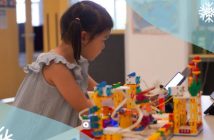
Though most kids anticipate the fun and lack of structured learning that summer brings, teachers and education experts know all too well the backslide in reading skills that can occur with this extended time off. Dubbed “summer slide” or “summer loss,” the regression in reading and math skills over the summer can set kids back as much as two or three months. In addition, a child who already struggles with reading is at greater risk of losing the reading skills they’re fighting to recover. Though school starts up again this month, it’s not too late to get a child back in the habit of reading to recover or maintain reading comprehension skills.
“Children who struggle with developing phonological awareness are at an especially high risk of losing their emerging reading skills during breaks from school, as these skills are build through intensive repetition and practice,” says Dr. Jacqueline Wolf, a licensed clinical psychologist at Eliott’s Corner. “Without daily practice, these children are at risk of losing the skills they worked so hard to build during the previous school year.”
Dr. Wolf explains that a child’s age is not a predictor of reading skill loss, but rather the child’s reading skill level. Precisely how much a child falls behind depends on the skills they have already developed and their reading situation at home, but the number generally falls between one and three months of loss. Studies have shown that a child who starts behind is likely to stay behind without intervention, and that a child who can’t read at grade level by fourth grade is likely to face an ongoing learning battle. Catching up is difficult, and the cumulative effect of that loss can put kids at a disadvantage that can be overcome only with extreme difficulty. This, however, is the worst-case scenario; the good news is that, with active parent involvement, the situation won’t come to that.
First, parents must know what to look out for in a child’s reading skills. “A key sign that your child is struggling to read is a general lack of progression despite typical learning experiences and instruction,”
explains Dr. Wolf. “A struggling reader will have a hard time remembering concepts that were previously taught. Thus, repetition and frequency is key.” Dr. Wolf, who offers reading support at Eliott’s Corner, specializes in identifying children with learning differences. She notes that dyslexia, the most common learning disability, involves the acquisition of reading skills. “Struggling readers begin to have challenges in other subject areas [starting from]the third grade, when curriculum changes from ‘learning to read’ to ‘reading to learn,’” she says.
If parents suspect that a child’s reading difficulty is linked to a learning
difference, early identification is crucial. If a parent notices that a child’s reading level seems to be regressing or that they’re struggling with a concept that was already learned, it’s time to up the reading sessions. Or better yet, keep the reading sessions consistent regardless of whether school is in session. For children struggling with the foundation of reading skills, Dr. Wolf recommends practicing reading skills at least four to five times per week in order to regain ground.
Whether a child is struggling or not, it’s important that they consistently remain engaged with reading. “The best way to keep a child’s interest in reading over the summer is to make it a daily routine and make it fun,” says Dr. Wolf. “Fifteen minutes of reading each day, no matter what type of reading material, is an excellent way to build reading fluency over the summer.”
Melissa Pierce, a speech language pathologist at Eliott’s Corner, recommends that parents take an active approach to their child’s reading by making the experience an interactive one. “Instead of passively reading while children listen, talk about the book and what is happening. Ask the child to make predictions and inferences, and discuss the characters. Talking while reading helps children develop their language skills.”
Pierce and Dr. Wolf both suggest coordinating real-life activities that correspond with the reading material. For example, if a child is reading about animals, take a trip to the zoo. This can also boost a child’s vocabulary by making reading more relevant and meaningful. Pierce also suggests arts and crafts projects to develop descriptive vocabulary and concept knowledge. She recommends No Time for Flash Cards, a site that provides craft ideas and related children’s books.
Dialogue remains important even with older children who can read on their own, reminds Pierce. Talking about the book can help reinforce narrative structure, and asking an older independent reader to read aloud can help increase fluency. “The best books for independent readers are those that include mostly words so they can read fluently, but also some challenging words that they need to sound out,” she says. “A book that is too easy can provide a break, but one that is too difficult may reduce motivation. It is important to find the ‘sweet spot’ of difficulty.”
It is also essential for parents to set a good example of reading for fun, and joining kids during daily reading time can help reinforce a reading habit. A child’s reading material doesn’t have to be limited to books; magazines and newspapers that are level-appropriate can help expose kids to new writing styles and vocabulary. Give your children the freedom to choose their own books, and then read along and discuss the book.
Eliott’s Corner will continue to offer reading support sessions during the fall. To find out more, contact the center directly or visit their website.
Photo Courtesy of Eliott’s Corner
This article originally appeared on p48-49 of the beijingkids August 2013 issue.
Check out the PDF version online at Issuu.com



